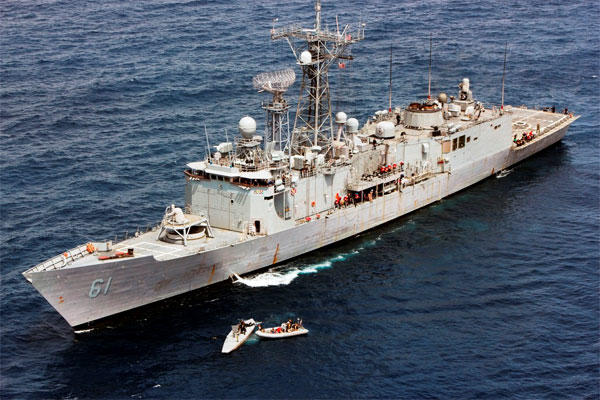USS INGRAHAM, At Sea -- Working with the Colombian Navy and Air Force, U.S. Navy and Coast Guard forces aboard USS Ingraham (FFG 61) captured a semi-submersible vessel packed with $107 million worth of cocaine in the Eastern Pacific in May.
The seizure of such a vessel - classified as a Self-Propelled Semi-Submersible - is a significant feat for U.S. and multinational forces that conduct year-round counter illicit trafficking operations in the waters off Latin America and the Caribbean.
Semi-submersibles are commonly used by illicit traffickers to move large amounts of drugs and other contraband because the vessel's low profile makes it extremely difficult to detect at sea. U.S. and regional partner nation law enforcement agencies rarely spot a semi-submersible on the high seas. And when they do, capturing a semi-submersible is very difficult since the crews often attempt to scuttle and sink the craft to dispose of evidence.
The recent semi-submersible seizure followed this script.
When the semi-submersible was tracked by Ingraham and visually located by its SH-60B Seahawk helicopter and rigid-hulled inflatable boat, the suspected traffickers punctured their hull in an attempt to scuttle the craft.
A U.S. Coast Guard Law Enforcement Detachment from Ingraham boarded the semi-submersible, detained the crew and gained control of the sinking vessel. Ingraham then quickly arrived on the scene and brought the semi-submersible alongside the ship. As the Colombian navy worked to tow the vessel into port, Sailors from Ingraham worked to pump water out of the slowly sinking semi-submersible and kept the vessel afloat long enough to retrieve the contraband loaded inside.
The Coast Guard said the semi-submersible was transporting about 2,380 kilograms of cocaine worth $107 million. Three suspects who crewed the semi-submersible were taken into custody.
The semi-submersible and cocaine seizure was part of Operation Martillo, a multinational effort targeting illicit traffickers and the movement of narcotics, precursor chemicals, bulk cash, and weapons in Central American waters.
"I could not be prouder of the dedication and professionalism the entire team displayed throughout the 48-hour operation to make this interdiction successful," U.S. Navy Cmdr. Joey Frantzen, commanding officer of Ingraham, said after the bust.
Units involved from Ingraham include Helicopter Anti-Submarine Squadron Light 49 and a U.S. Coast Guard Law Enforcement Detachment. Ingraham is homeported in Everett, Washington.
"The takedown and subsequent seizure of the [semi-submersible] trafficking vessel represents the hard work and tireless efforts of the Colombian Navy, Colombian Air Force, U.S. Navy, U.S. Coast Guard and Joint Interagency Agency Task Force South," Frantzen said.
Self-Propelled Semi-Submersibles are low-profile vessels capable of carrying a crew of four and vast quantities of contraband. Constructed of low-signature materials, the craft are extremely difficult to locate. The vessels are designed to have a reduced wake and lowered thermal signature. In addition, a semi-submersible has an extremely low freeboard. Transiting along the surface, the watercraft is difficult to observe visually.
Under the coordination of the Key West, Florida-based Joint Interagency Task Force South, U.S. military, Coast Guard and law enforcement agencies, and regional partner nation law enforcement agencies patrol the waters in the Caribbean Sea, Gulf of Mexico, and the eastern Pacific on a year-round basis in an effort to detect, monitor and interdict illicit traffickers.
During at-sea busts in international waters, a suspect vessel is initially located and tracked by U.S. military or law enforcement aircraft or vessels. The actual interdictions - boarding, search, seizures and arrests - are led and conducted by U.S. Coast Guard Law Enforcement Detachments or partner nation law enforcement agencies.
U.S. maritime law enforcement and the interdiction phase of counter-smuggling operations in the Eastern Pacific occurs under the tactical control of the 11th Coast Guard District headquartered in Alameda, Calif.
Although Ingraham has already disrupted 1,375 Kilograms of cocaine during her deployment, this is her first successful interception since arriving in the region to support Operation Martillo.
Operation Martillo (Hammer) includes the participation of fourteen nations that are working together to counter transnational organized crime and illicit trafficking in coastal waters along the Central American isthmus. Joint Interagency Task Force South, a National Task Force under U.S. Southern Command, oversees the detection and monitoring of illicit traffickers and assists U.S. and multinational law enforcement agencies with the interdiction of these illicit traffickers. U.S. Naval Forces Southern Command/U.S. 4th Fleet supports U.S. Southern Command's joint and combined military operations by employing maritime forces in cooperative maritime security operations in order to maintain access, enhance interoperability, and build enduring partnerships in order to enhance regional security and promote peace, stability, and prosperity in the Caribbean, Central and South American regions.





























